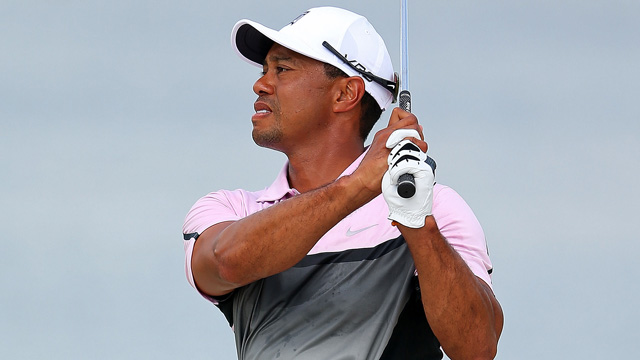NEWS
Tiger Woods back from back surgery, but where is he going from here?
By Doug Ferguson
Published on

BETHESDA, Md. – Tiger Woods back on the golf course is a big deal.
At his first competitive hole in three months, fans stood side-by-side down the entire left side of the 221-yard 10th hole and three-deep around the green at 8:00 a.m. last Thursday, with hundreds more watching from the patio and balcony of the multi-tiered clubhouse at Congressional. Woods always has been must-see golf.
But what did they come to see?
Woods appears to have his health back. He said as much following his brief stay at Congressional – no pain, no twinges, no worries from back surgery on March 31. That allowed him to use the word "encouraged" after missing the cut by four shots.
What did they expect to see?
Because until Woods gets his game back, the excitement over his return will revolve more around his incomparable past than the potential of his future.
Let's be realistic. Woods is 38 going on something much older. He has more surgeries (five) than green jackets (four). And for all the talk about his swing being slightly shorter or any other technical aspect of his game, what can't be ignored is he no longer makes as many putts as he once did. No one can make them all forever.
Most peculiar was the reference to the Quicken Loans National as a rehab assignment.
SEE YOU NEXT YEAR: Tom Watson can go ahead and make travel plans for summer 2015
Maybe that was the case, but it wasn't always like that. When he was younger – and healthier – Woods could return from a long layoff and play as if he had never been gone. He missed two months after his first knee surgery as a pro and won his first tournament back by four shots.
He was able to practice more in those days, and that should not be overlooked. Woods didn't say exactly how long he had been practicing before he arrived at Congressional except that he worked his way through the bag – 10 additional yards every day or two – until he was hitting drivers "a couple of weeks ago."
It was unusual to hear Woods say when he announced his return that he would be rusty, and then to say when he arrived at Congressional that while winning remains the goal, it surely was going to be harder.
His expectations clearly were lower than ever, and perhaps ours should be, too. That just goes against the way he approached the game his entire life.
Woods played without pain, and that should count for something. It was the first step on the road back, however long that road is, and it would be foolish to allow one tournament to be the measure of his season, however short his season turns out to be.
Woods has three tournaments – the British Open, Bridgestone Invitational and PGA Championship – to qualify for the FedExCup playoffs. Otherwise, he would have more than a month off. And that might include the Ryder Cup.
U.S. Captain Tom Watson wants him on the team, though he offered a strong caveat on Tuesday.
"I want him on the Ryder Cup team if he's healthy – and playing well," Watson said.
But what if he's playing like anyone else?
Woods says he did not rush his return to golf, though he should have known there would be a rush to judgment. This was his first competition in three months. Then again, he wasn't playing all that great even before his surgery.
He said the back problems would come and go until they started showing up with alarming frequency, which led to surgery to alleviate a pinched nerve. The first sign of trouble dates to August 2012 at Bethpage Black, where he struggled to bend over and stick a tee in the ground.
He won five times the next year.
That would suggest it's wise to give him time – more than one tournament, maybe even more than three.
Predictions are a dangerous business in any sport, especially golf. Woods remembers the skeptics who questioned his first big swing change with Butch Harmon, the one that eventually produced his greatest era of dominance. The critics had a field day with Woods working with Hank Haney until he delivered another spectacular run. In a two-year period covering 34 tournaments, he won 18 times (including four majors) and was runner-up six times.
That span ended with the 2008 U.S. Open at Torrey Pines, right before his fourth and most invasive knee surgery. He has not won a major since.
Woods is playing golf again, and that's important.
What really would build the excitement is to win. That will get people talking about what he might do instead of what he once did.
